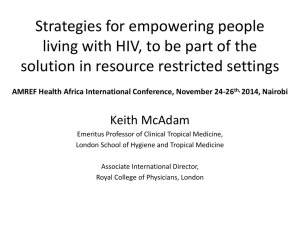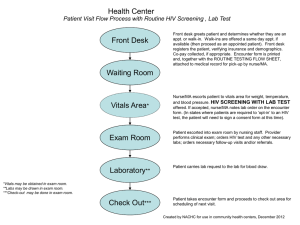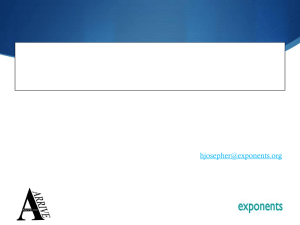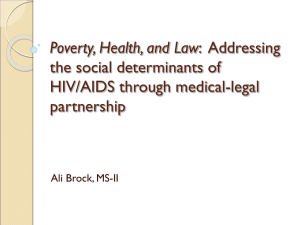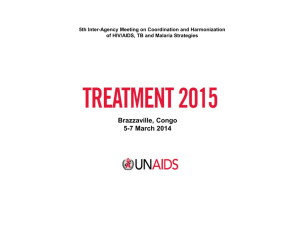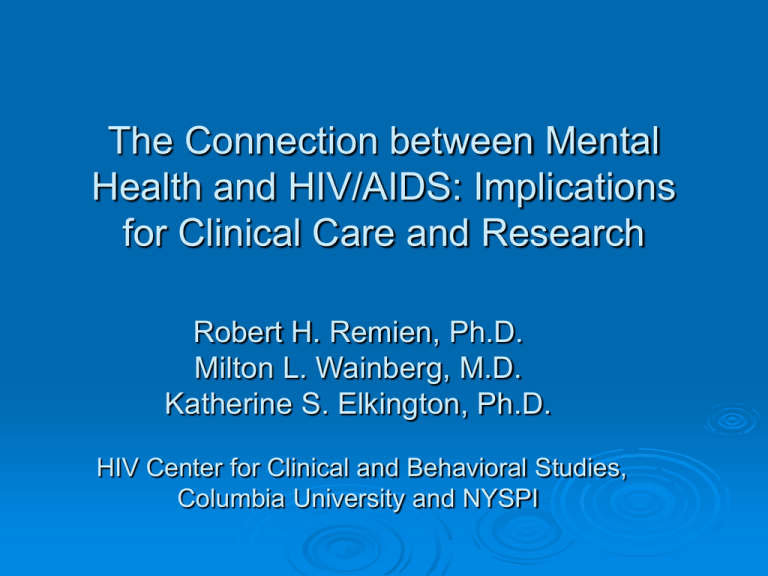
The Connection between Mental
Health and HIV/AIDS: Implications
for Clinical Care and Research
Robert H. Remien, Ph.D.
Milton L. Wainberg, M.D.
Katherine S. Elkington, Ph.D.
HIV Center for Clinical and Behavioral Studies,
Columbia University and NYSPI
Overview
• The Intersection of mental health,
substance abuse and HIV/AIDS
• Deployment-focused intervention
development:
• Three research examples
The Intersection of Mental
Health, Substance Use and
HIV/AIDS
Mental illness and HIV Risk Behaviors
• Specific Diagnoses: Inconsistently associated with risk
• Symptoms:
• Positive psychotic sx cluster multiple partners; IDU
• excitement sx sexual activity; sex exchange; condom use
• Depressed/anxious sx STDs; poor condom negotiation skills; multiple
partners; inconsistent condom use
• High rates of co morbid substance use
• High rates of childhood abuse
• Problematic current interpersonal relationships
• Poverty / low SES : sex exchange
• Stigma and Discrimination
(Meade & Sikkema, 2005, 2006; Donenberg & Pao, 2005)
Substance Use and HIV Risk Behaviors
• Substance use and disorder linked to HIV/STI
risk behaviors
• Type of substance: alcohol, stimulants, club drugs
• Amount and frequency of use: Addiction – sex
exchange
• Motivation for use (social anxiety; expectancy theory)
• Role of environmental factors: peers, family
• Method of data collection
• Cross-sectional, longitudinal, event-level
analysis (daily diary studies)
5
Mental Health and Substance Use Problems
Among Subpopulations at High Risk for HIV
• IDU: ↑ rates of SUD and other psychiatric disorders
• MSM: ↑ rates of SUD and depression
• SW: ↑ rates of childhood sexual abuse, SUD, and PTSD
• Criminal/Juvenile justice: ↑ childhood sexual abuse; SUD
and psychiatric disorders (particularly PTSD)
• All groups: Stigma; legal sanctions; poor access to
services; high risk interpersonal relationships — all
associated with ↑ risk behaviors
Psychiatric and Substance Use
Disorders among PLWHA
RAND HCSUS Study: 2,864 HIV+ Medical Patients
•
•
Any Psychiatric Disorder:
Major depression
Dysthymia
Generalized anxiety disorder
Panic attack
Drug dependence
Problematic alcohol use
•
(Bing et al Arch. Gen. Psych. 2001)
•
•
•
•
•
48%
36%
27%
16%
11%
13%
19%
Impact of Mental Health and
Substance Use Problems for PLWHA
Mental health and substance use problems
can:
• Impair the quality of one’s life
• Interfere with HIV treatment adherence
• Interfere with self-care behaviors and
increase risk behaviors
• Result in acting out verbally or physically
• Impair ability to cope with daily events,
including childcare
• Increases morbidity and mortality
Alcohol myopia
“Social lubricant”
(self medication)
Acute intoxication
(e.g. impaired judgement)
Symptoms
(e.g. paranoia, anxiety,
depression, psychosis)
Addiction
Substance
Ab/use
Child abuse
Stigma
Strained/poor
family & peer
relationships
Mental
Illness
IPV
HIV RISK
BEHAVIORS
Non
Adherence to
treatment
and Care
Interpersonal
Marginalized
/risky peer
groups
Environmental/
Structural
Transportation/
access to health care
Poverty
Neighborhood
Disintegration
Poor housing
Stigma
Deployment-Focused
Intervention
Development
Implications for
Intervention, Treatment,
and Care
HIV Prevention with
Psychiatric Patients in Brazil:
Planning a National Response
Milton L. Wainberg, PRISSMA
MD
Project / NIMH R01-65163/ 2002-2006
Associate Clinical Professor of Psychiatry, Columbia University
Background
Worldwide, adults with severe mental illness
(SMI) have elevated rates of HIV infection
(between 0.8% and 23.8%) relative to the
general population (3 to 5 times)
Few (n=7; 919 participants) HIV prevention
interventions have been tested for efficacy –
all of them in the US (Kalichman 1995, Kelly 1997, Susser 1998,
Weinhardt 1998, Otto-Salaj 2001, Carey 2004, Berkman 2006)
There is no single “gold standard” HIV
prevention intervention for the SMI
PRISSMA Project / NIMH R01-65163/ 2002-2006 & 2006-2011
Summary of HIV Prevention
Research among SMI - 2001
US and Other Countries
1. Are at disproportionate risk
Brazil
Yes?
2. Are willing to talk about and are reliable when
reporting their sexual activities and use of
alcohol/drugs
?
3. Do not experience adverse reactions when
participating in HIV prevention efforts (e.g.,
increase in sexual activity or psychiatric
symptoms)
?
4. Can benefit from participating of HIV
prevention interventions
5. Are seldom offered HIV prevention
interventions
PRISSMA Project / NIMH R01-65163/ 2002-2006 & 2006-2011
?
?
PRISSMA I Model
AIDS and Behavior, 2007
1) Optimizing Fidelity:
HIV Prevention
Principles
2) Optimizing Fit:
Adaptation
Principles
3) Balancing Fidelity
and Fit: Intervention
Adaptation
4) Pilot Testing and Refining:
Final Intervention
PRISSMA Project / NIMH R01-65163/ 2002-2006 & 2006-2011
RCT Study Design
Screen
Baseline assessment*
Orientation
HIV – 8 sessions
Health – 8 sessions
Post-intervention assessment**
3- & 6-months follow-up assessments*
HIV – 3 boosters
Health – 3 boosters
Post -booster assessment**
12-months follow-up assessment*
PRISSMA Project / NIMH R01-65163/ 2002-2006 & 2006-2011
* Diagnoses, risk behaviors, mediators/moderators
** Process measures, mediators/moderators
Total screened
3811
Recruitment
Total eligible
1579
Interested
1348
Baseline done
916
Consented &
Eligible
609
Recruitment ended 7 months early!!!!!!
464 Randomized
Into 37 waves
(HIV vs Health)
PRISSMA Implementation
Month
Jan
Feb
March
April
Intervention
Booster
HIV
Saúde
May
HIV
June
Saúde
July
Augost
Sept
Oct
HIV
Saúde
Nov
HIV
Dec
Saúde
Summary of HIV Prevention
Research among SMI – 2011/2014
US and Other Countries
Brazil
1. Are at disproportionate risk
Yes
2. Are willing to talk about and are reliable when
reporting their sexual activities and use of
alcohol/drugs
Yes
3. Do not experience adverse reactions when
participating in HIV prevention efforts (e.g.,
increase in sexual activity or psychiatric
symptoms)
Yes
4. Can benefit from participating of HIV
prevention interventions
5. Are seldom offered HIV prevention
interventions
PRISSMA Project / NIMH R01-65163/ 2002-2006 & 2006-2011
Hopefully
No
Working with systems from
the beginning: A Case
example with JJS youth
K01MH089832 ; PI: Elkington
What’s Unique about JJS Youth?
• Juvenile detainees are at high risk for HIV/STIs:
Higher rates of HIV/STI risk behaviors
Higher rates of substance use and mental
health (MH) disorders
Numerous contextual factors that increase
risk
• Peers, families, neighborhoods
Intervening with Just the Youth….
…is that Enough?
• Need to involve other domains or systems of risk
and protection
• Systems may act directly (e.g. family, peer group) or
may be more distal (neighborhood, JJS)
• Family is key to promoting or off-setting risk
• GOAL: Target HIV/STI risk by addressing MH and SU
problems and improving family functioning within context of
the JJS
Modified Ecodevelopmental Model
MACROSYSTEM
Social-Cultural Context
Immigration
Policy
Exosystem
•Parents’ social support
•Parents’ stress
Language
Poverty
Cultural
Family MICROSYSTEM
• Family functioning (conflict/support)
• Caregiver monitoring/supervision
• Caregiver discipline
• Caregiver-youth communication
• Caregiver-youth relationship satisfaction
Family-School Mesosytem
Parental monitoring homework
School Microsystem
School Bonding
Academic Achievement
Family-Peer Mesosytem
Parental monitoring of
peer activities
Youth
• Substance use
• Mental Health
• HIV/STI knowledge
• Safer sex and drug use
attitudes
• Safer sex self-efficacy
• Perceived HIV risk
• Safer sex behavior
skills
HIV/STI
sexual risk behavior
Szapocznik & Coatsworth, 1999)
Peer Microsystem
Perceived peer HIV/STI behavior
Perceived peer HIV/STI norms
Developing the intervention
• To develop and implement effective interventions that
are targeted and sustainable:
1. Achieve buy in from treatment system and keystakeholders involved
• Probation, staff, families, youth
2. Formative work
• Understand logistic and institutional-cultural contextual
factors of the probation center and staff
• Understand context of sexual risk for JJS youth
including the role of the family
Modified Ecodevelopmental Model
MACROSYSTEM
Social-Cultural Context
Immigration
Policy
Exosystem
•Parents’ social support
•Parents’ stress
Language
Poverty
Cultural
Family MICROSYSTEM
• Family functioning (conflict/support)
• Caregiver monitoring/supervision
• Caregiver discipline
• Caregiver-youth communication
• Caregiver-youth relationship satisfaction
Family-School Mesosytem
Parental monitoring homework
School Microsystem
School Bonding
Academic Achievement
JJS
Family-Peer Mesosytem
Parental monitoring of
peer activities
Youth
• Substance use
• Mental Health
• HIV/STI knowledge
• Safer sex and drug use
attitudes
• Safer sex self-efficacy
• Perceived HIV risk
• Safer sex behavior
skills
Peer Microsystem
Perceived peer HIV/STI behavior
Perceived peer HIV/STI norms
HIV/STI
sexual risk behavior
24
Phase 1 – Formative phase
• Interview probation staff (n=12)
What is their perception of youth HIV/STI risk?
What is role of probation department in providing
HIV/STI programming?
How would an intervention fit into current
programming….. climate…… culture?
• All staff perceived their youth to be at considerable
risk for HIV/STIs and needed intervention program:
Sexually active at young ages; ↑ pregnancies
Impulsive; MH and SA abuse problems
Limited supervision and problematic role models
(peers and family)
Implications for intervention development and
delivery:
• Great – we are on the right track, sexual risk is a
problem
• Addressing MH issues and SA is key
• Staff think this is important to address
• Staff recommend program to families and talk up
program to get resistant families involved
• Providers struggled to reconcile their role as POs with
their responsibility of providing youth with services
“It’s not on the form so we don’t ask”
Address presenting problem rather than provide prevention for
a potential problem
Social work vs. law enforcement: Differing views held by staff
Sex risk, HIV/STI rarely bought up - believe youth will not talk
Staff do not feel adequately trained to address sexual risk but
would if they were trained
Implications for intervention development:
• Add a sex risk screening question to intake assessment?
• Alter culture: promote prevention for non-probation related
issues
• Task shifting: train subset of POs in youth sexuality and
sexual risk reduction to deliver intervention
• How would an intervention fit into current
programming….. climate…… culture?
POs currently co-lead groups onsite at the probation
department
On-site vs. off-site programming: Both services are
available.
POs busy schedule: is there time to add additional
programs
Family engagement always tricky
Implications for intervention development:
• Build intervention into existing services and bundle
• Work with community providers
• Build in participation in HIV program as mandatory part of
their probation
Developing the intervention
cont’d
3. Develop a family-based intervention building on an
existing efficacious youth-only intervention
designed for youth on probation
• 1st work group : youth and caregivers
• Review interview data and existing interventions; role play
and suggest changes
• 2nd work group: probation staff
• Work together to create actual intervention sessions
drawing from other family-based interventions
4. Pilot test the intervention in department of probation
•
•
Deliver as part of co-located services offered
Work with CBOs to deliver to JJS families


